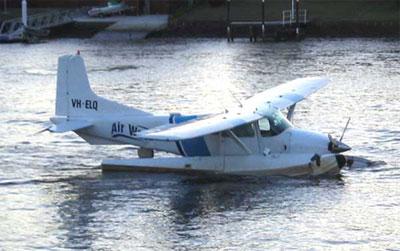The Australian Transport Safety Bureau did not conduct an on-scene investigation of this occurrence. The report presented below was prepared principally from information supplied to the Bureau.
REPORTED INFORMATION
On 3 October 2004, a Cessna 185 float plane, registered VH-ELQ, was being used to conduct joy flights from the Broadwater at Southport, Queensland. The pilot, who was the company chief pilot, had conducted a series of short flights during the day and reported that the aircraft operated normally throughout. The last flight of the day was to be a 10-minute scenic flight at 1,000 ft, south from the Broadwater to Jupiter's Casino and return. The pilot reported that, prior to that flight, the right-wing tank contained 45 L of fuel. The left-wing tank was empty.
The flight departed with three passengers at about 1650 Eastern Standard Time. The take-off and southern leg of the flight proceeded normally, and the pilot initiated a wide right turn at 1,000 ft abeam Jupiter's Casino for the return leg. The pilot reported that, to give the passengers the best view from the aircraft, he conducted a 'flat turn' using little or no bank, by applying a combination of right rudder and opposite aileron control. The pilot reported that, about 30 seconds after resuming straight and level flight, the engine 'gave a couple of splutters' and lost power and he conducted an uneventful precautionary landing on the Nerang River with partial engine power.
The pilot said that, after landing, he shut down the engine and confirmed that the right-wing tank contained 40 L of fuel. He then drained fuel from the fuel strainer to clear any water that might have been present. The pilot then restarted the engine. All engine instrument indications were normal. He said that he manoeuvred the aircraft left and right while taxiing and increased engine power. The aircraft's speed increased, and he was able to manoeuvre the aircraft so that the floats were on the step1. The engine continued to operate normally. The pilot reported that he then set maximum engine power, and after noting that the engine was delivering full power, continued to accelerate and take-off. Shortly after the aircraft became airborne, he initiated a gentle climbing right turn to follow a bend in the river. A very short time later, the engine again lost power. The pilot said that he lowered the nose of the aircraft to land back on the river but saw a cluster of brightly coloured balls indicating the presence of powerlines immediately ahead of the aircraft.

He decided to fly over the powerlines and as he was raising the nose to achieve that, there was a power surge from the engine. After the aircraft cleared the wires, the pilot observed that the indicated airspeed was below 45 kts. He reported that the aircraft then descended rapidly, heavily impacting the water. The pilot assisted the passengers from the aircraft onto waiting boats. There were no injuries.
Photographs of the aircraft showed that both floats and their supports had been substantially damaged and forced upwards from their normal position so that the aircraft's lower fuselage was in contact with the water.

The forward section of the right float had a large cut from one or more propeller blade strikes, indicating that the engine was operating when the aircraft impacted the water.
The pilot reported that at the time of the first forced landing, there was no other company person on duty from whom he could seek advice. Further, he could see no suitable location on the river where he could anchor or beach the floatplane. Last light was approaching, and he was considering the welfare of the passengers. He thought that the engine problem may have been caused by the fuel quantity, or by water in the fuel. However, after he confirmed the amount of fuel in the right-wing tank and conducted a fuel drain, he concluded that he could fly the aircraft back to the Broadwater. The pilot reported that before the take-off, he did not check beyond the bend in the river for overhead obstructions.
The operator reported that a mobile telephone was carried on the aircraft, which provided the pilot with the means to contact the operator or the company's approved maintenance organisation.
The aircraft's maintenance organisation subsequently reported that they drained all fuel from the right-wing tank after the aircraft was recovered. The right-wing tank contained 37 L of fuel. The left-wing tank was empty. There was no water in the fuel. There was a minor amount of rust coloured sediment in the fuel strainer, but the quantity was insufficient to affect the flow of fuel to the engine. There was no evidence of the sediment in any other filter or the fuel distributor. The maintenance organisation also reported that there were no obstructions to the flow of fuel from either the forward or the rear outlet pipes from the right-wing fuel tank to the fuel accumulator tank.
1 'on the step' refers to the float transitioning from displacement mode to planning mode, as the speed increases on the surface of the waters.


